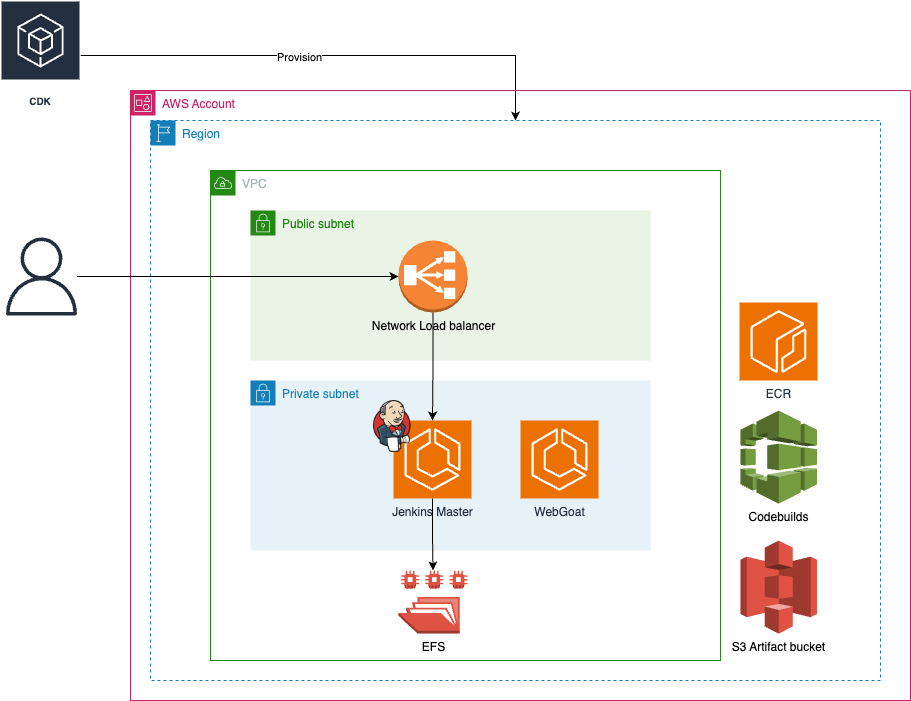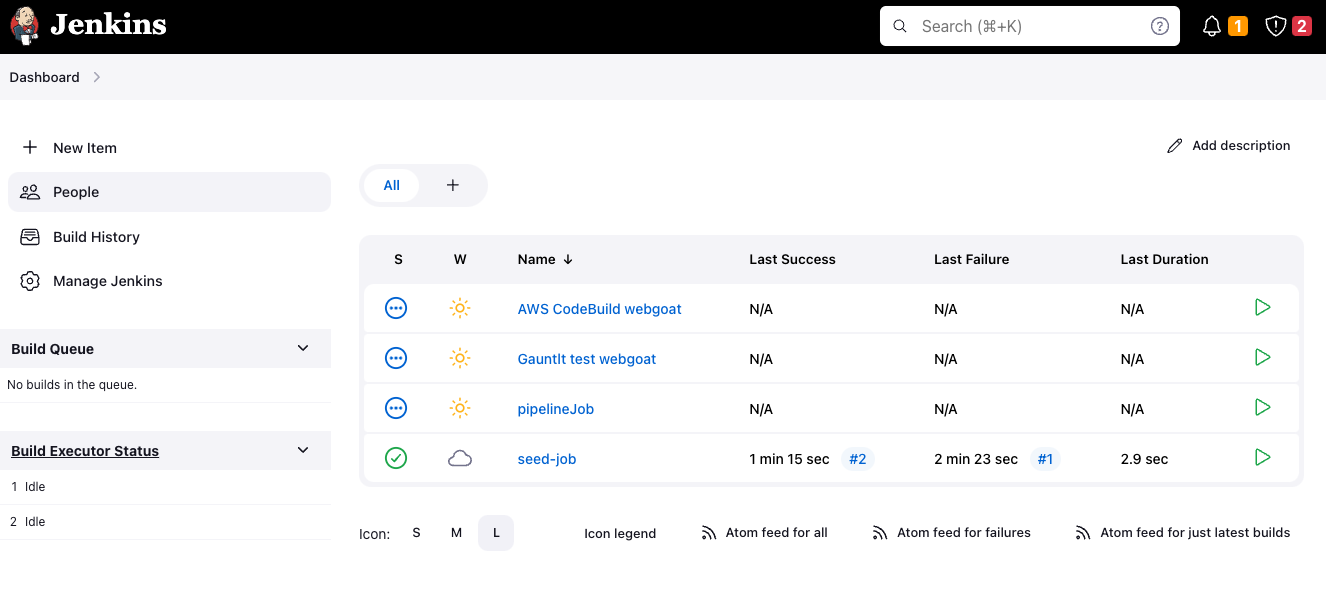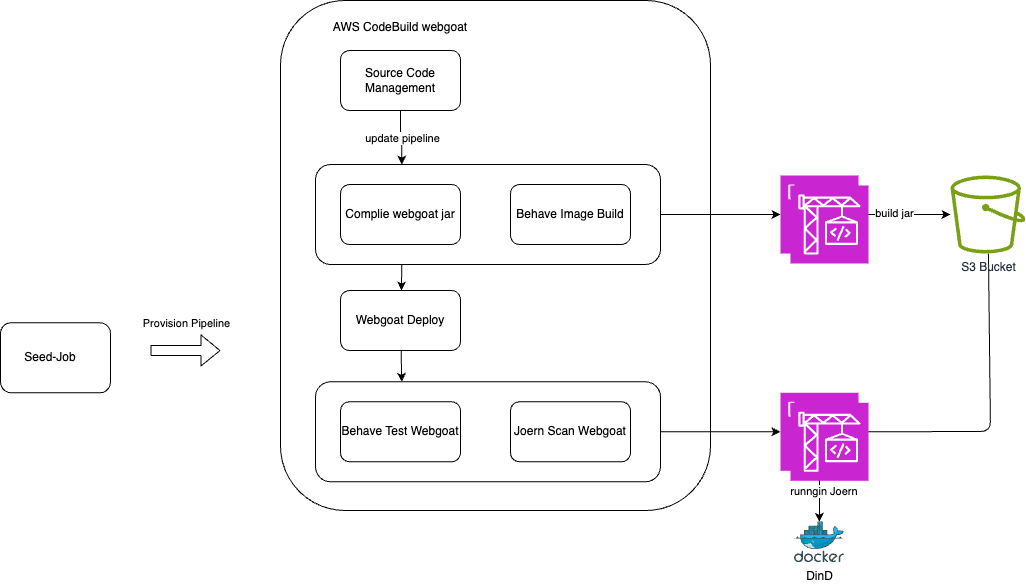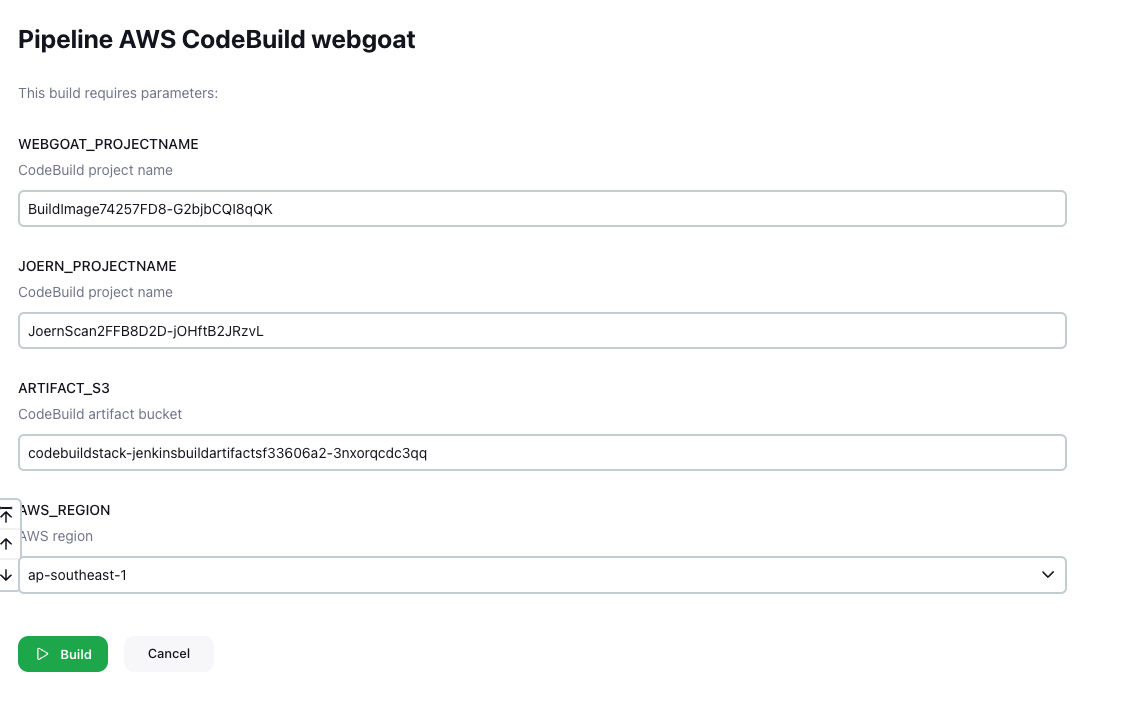This guide provides step-by-step instructions for setting up a DevSecOps Jenkins scanner using AWS native services and Jenkins. Follow these instructions to automate security scanning in a WebGoat application using CDK for infrastructure provisioning and Jenkins DSL for pipeline configuration.
- 1. DevSecOps Jenkins Scanner
- 2. Objective
- 3. Technical Stack
- 4. Prerequisites
- 5. Provision AWS resources
- 6. Jenkins pipleine overview
- 7. Advance Task (Optional)
- 8. Clean up Action
- 9. Reference
Software security vulnerabilities have become a major concern for enterprises, and introducing security testing and scanning tools into the CI/CD pipeline is a crucial step in their DevSecOps journey. However, while security scanners can be useful when configured correctly with rule customization, they often require advanced security and software engineering skills, such as understanding complex exploits and Abstract Syntax Trees (AST). Additionally, these tools may not cater to testing security-related business logic or application-specific corner cases, and they may lack the flexibility to manage complicated test cases at scale. As a result, many enterprises face challenges after starting their shift-left security initiatives because simply plugging in scanners and passing scan results to developers does not truly constitute a shift-left approach; it merely shifts responsibility.
Behavior-Driven Development (BDD) for security can be a lifesaver for software engineers dealing with security problems. Our sharing at the AWS Summit, "Dealing with Challenges of DevSecOps Practice in Enterprises" (https://hktw-resources.awscloud.com/aws-summit-hong-kong-2023/dealing-with-challenges-of-devsecops-practice-in-enterprises), introduced the concept of BDD security test automation and fuzzing techniques long practiced by big tech companies and major financial services institutions. In this guide, we will walk you through a hands-on lab where you can get your hands dirty and build your first security test cases.
The objective of this installation guide is to demonstrate how to use AWS native services and Jenkins to automate security scanning in a WebGoat application. The guide will cover the use of CDK for infrastructure provisioning and Jenkins DSL for pipeline configuration, providing a practical example of integrating security testing into the CI/CD pipeline.
The following technical stack will be used in this installation:
- CDK - Infrastructure as Code (IaC), provides a library of constructs that cover many AWS services and features
- Jenkins - Jenkins is an open source automation server that helps automate various parts of the software development process
- Codebuild - Fully managed build service used as a build server and Jenkins agent
- Joern - A tool for analyzing source code, bytecode, and binary executables for security vulnerabilities
- WebGoat - An insecure web application designed for developers to test and learn about common web application vulnerabilities
- Cognito
- Behave
The infrastructure stack will be provisioned using CDK. Please refer to the provided architecture diagram for an overview of the overall architecture.

The project has the following folder layout:
devsecops-jenkins-scanner
├── README.md
├── cdk-jenkins - CDK code
├── gauntlt - BDD scanning
├── behave - BDD scanning
├── jenkins-master-image - Jenkins configuration file
└── local - local docker development
Before starting the installation, ensure that the following prerequisites are met:
- An AWS account with CLI access (
AWS_ACCESS_KEY_IDandAWS_SECRET_ACCESS_KEY) - A Linux-based platform (Recommended: AWS Cloud9)
- Docker installed
- Fork the https://github.com/dictcp/devsecops-jenkins-scanner repository under your GitHub account, as you will need to make changes to the repository. Shortenurl - https://bit.ly/apr26
Follow the steps below to install and configure the DevSecOps Jenkins scanner.
- Create a new Cloud9 Environment through the AWS console.
- Follow the instructions to provide the required inputs:
- Name
- Instance Type (Recommended: t3.small or more powerful)
- Platform - Amazon Linux 2023
- Use AWS Systems Manager (SSM) for connection
- VPC can be the default VPC
- Click on "Details" and "Manage EC2 Instance" to increase the storage to 30GB.
- Open your Cloud9 instance in the console and start the configuration below.
-
Set up the environment:
export AWS_PAGER= ;\ export AWS_REGION=ap-southeast-1 ;\ export ACCOUNT=$(aws sts get-caller-identity --out json --query 'Account' | sed 's/"//g') ;\ export YOURID=YOUR GITHUB ID
-
Fork the GitHub repository, generate an SSH access key (
ssh-keygen -t rsa), and add your SSH public key to the repository's "Deploy Keys" section to grant access rights. -
Download the source code from your forked repository:
git clone git@github.com:$YOURID/devsecops-jenkins-scannerandcd devsecops-jenkins-scanner -
Modify the repository name:
find . -type f -exec sed -i "s/dictcp/$YOURID/g" {} + -
git add . && git commit -m "update" -m "change the repo name" && git push
Follow the steps below to install and configure the DevSecOps Jenkins scanner:
-
Setup additional environment variable
curl ifconfig.ioget your local IP address and create env var in cloud9export YOURIP=XXX.XXX.XXX.XXXexport AWS_PAGER= ;\ export AWS_REGION=ap-southeast-1 ;\ export ACCOUNT=$(aws sts get-caller-identity --out json --query 'Account' | sed 's/"//g') ;\ export CDK_DEFAULT_ACCOUNT=$ACCOUNT ;\ export CDK_DEFAULT_REGION=$AWS_REGION ;\ export CURRENT_IP=$YOURIP ;\ echo -e "$ACCOUNT \\n$CURRENT_IP" ;
-
Initialize the CDK Toolkit:
install the package
pip install aws-cdk-lib constructscd cdk-jenkins cdk bootstrap aws://$ACCOUNT/$AWS_REGION
-
Use cloudformation list command to check the
CDKToolkitexistaws cloudformation list-stacks --stack-status-filter CREATE_COMPLETE --query "StackSummaries[].[StackName,StackStatus]" --output table -
Deploy the stack using CDK:
cdk synth --context current_ip=$CURRENT_IP cdk deploy --context current_ip=$CURRENT_IP --require-approval never --progress events --all #cdk deploy --context branch_or_ref=develop --context current_ip=$CURRENT_IP --all #with confirmation
Stack Time Network stack 157s Jenkins Master Stack 317s WebGoat Stack 191s CodeBuild Stack 71s -
Update the codebuild project variable
bash local/generate_output.sh -
git add . && git commit -m "update" -m "config the codebuild name" && git push -
Capture the
JenkinsMasterStack.LoadBalancerDNSNameoutput to access the Jenkins Master server
jenkins-master-image
├── Jenkinsfile - groovy script of pipeline
│ ├── codebuild-webgoat
│ ├── gauntlt-webgoat
│ └── pipelinejob
├── createJobs.groovy - the seed job to provision the pipeline in Jenkins file
This code sets up the following resources:
- An ECS cluster named "jenkins-cluster"
- An EFS file system named "JenkinsFileSystem"
- An ECS task definition named "jenkins-task-definition" with a memory limit of 4096 MB and 2048 CPU units
- A volume named "jenkins-home" configured to use the EFS file system with transit encryption and access point-based authorization
- A container named "jenkins" that uses an image from an ECR repository named "jenkins-master" with the "latest" tag
- Logging configuration for the container to send logs to CloudWatch Logs with the stream prefix "jenkins"
current_dir = os.path.dirname(__file__)
asset = DockerImageAsset(self, "jenkins-master",
directory=current_dir)
cluster = ecs.Cluster(
self, "jenkins-cluster", vpc=vpc, cluster_name="jenkins-cluster"
)
file_system = efs.FileSystem(
self, "JenkinsFileSystem", vpc=vpc, removal_policy=RemovalPolicy.DESTROY
)
task_definition = ecs.FargateTaskDefinition(
self,
"jenkins-task-definition",
memory_limit_mib=4096,
cpu=2048,
family="jenkins",
)
task_definition.add_volume(
name="jenkins-home",
efs_volume_configuration=ecs.EfsVolumeConfiguration(
file_system_id=file_system.file_system_id,
transit_encryption="ENABLED",
authorization_config=ecs.AuthorizationConfig(
access_point_id=access_point.access_point_id, iam="ENABLED"
),
),
)
ecr_repository = ecr.Repository.from_repository_name(
self, "jenkins-master", "jenkins-master")
container_definition = task_definition.add_container(
"jenkins",
#image=ecs.ContainerImage.from_registry("jenkins/jenkins:lts"),
image = ecs.ContainerImage.from_ecr_repository(ecr_repository, tag="latest"),
logging=ecs.LogDriver.aws_logs(stream_prefix="jenkins"),
)- access the Jenkins using NLB dns name
- Execute the seed-job to provision the pipeline in Jenkins.
- Execute
AWS_CodeBuild_webgoatpipeline
- update the codebuild name in parameter/configure/groovy
This BuildSpec file sets up the Docker environment, authenticates with ECR, pulls a Docker image from ECR, runs behave command inside the Docker container , and captures the output of that command. It is commonly used for building and testing containerized applications within the AWS CodeBuild service.
version: 0.2
phases:
install:
commands:
- nohup /usr/local/bin/dockerd --host=unix:///var/run/docker.sock --host=tcp://127.0.0.1:2375 --storage-driver=overlay2 &
- timeout 15 sh -c "until docker info; do echo .; sleep 1; done"
pre_build:
commands:
- echo Logging in to Amazon ECR...
- aws ecr get-login-password --region $AWS_REGION | docker login --username AWS --password-stdin $AWS_ACCOUNT_ID.dkr.ecr.$AWS_REGION.amazonaws.com
- aws --version
- pwd && ls -lR
build:
commands:
- echo Build started on `date`
- echo Running your command in Docker...
- docker pull $ECR_URL:latest
- |
docker run \
--rm \
-e APP_URL=$APP_URL \
-e PYTHONPATH=/app/behave/libs \
-v $(pwd):/app \
$ECR_URL:latest \
behave /app/behave/features | tee output.txt
- echo "Command output:"
- cat output.txt
post_build:
commands:
- echo Build completed on `date`This code sets up a CodeBuild project named BehaveImageBuild that builds a Docker image from the source code in the specified GitHub repository. The built image is then pushed to an ECR repository specified by the ECR_URL environment variable. The build specification file and the branch or Git reference to use are specified as inputs to the CodeBuild project.
branch_or_ref=self.node.try_get_context("branch_or_ref") or "main"
# code build project for execute codebuild_behave_image_build_buildspec.yaml
codebuild_behave_image_build = codebuild.Project(
self,
"BehaveImageBuild",
build_spec=codebuild.BuildSpec.from_asset(
"codebuild_behave_image_build_buildspec.yaml"
),
source=codebuild.Source.git_hub(
owner="dictcp", repo="devsecops-jenkins-scanner", branch_or_ref=branch_or_ref
),
environment=codebuild.BuildEnvironment(
build_image=codebuild.LinuxBuildImage.AMAZON_LINUX_2_5,
compute_type=codebuild.ComputeType.MEDIUM,
privileged=True,
),
environment_variables={
"ECR_URL": codebuild.BuildEnvironmentVariable(
value=behave_ecr_repository.repository_uri
),
"AWS_ACCOUNT_ID": codebuild.BuildEnvironmentVariable(
value=os.getenv("CDK_DEFAULT_ACCOUNT") or ""
),
},
)
behave_ecr_repository.grant_pull_push(codebuild_behave_image_build)IAM role attach to the cd
# code build project for execute codebuild_behave_image_build_buildspec.yaml
# Create the IAM role for CodeBuild
# Define the policy statements
policy_statements = [
iam.PolicyStatement(
effect=iam.Effect.ALLOW,
actions=[
"iam:PassRole",
"sts:AssumeRole"
],
resources=["*"]
),
]
# Create the policy
policy = iam.Policy(
self,
"CodeBuildPolicy",
statements=policy_statements
)
codebuild_role = iam.Role(
self,
"CodeBuildRole",
assumed_by=iam.ServicePrincipal("codebuild.amazonaws.com"),
managed_policies=[
iam.ManagedPolicy.from_aws_managed_policy_name("AWSCodeBuildAdminAccess"),
iam.ManagedPolicy.from_aws_managed_policy_name("AWSCloudFormationFullAccess"),
iam.ManagedPolicy.from_aws_managed_policy_name("AmazonSSMFullAccess"),
iam.ManagedPolicy.from_aws_managed_policy_name("AmazonECS_FullAccess"),
iam.ManagedPolicy.from_aws_managed_policy_name("AmazonEC2ContainerRegistryFullAccess"),
]
)Grant S3 accesst to Codebuild
s3_bucket.grant_read_write(codebuild_joern)Use case:
- Compliance-Based Test Cases: These test cases are directly derived from compliance requirements, ensuring that the application or system under test adheres to the specified regulations or standards.
- Business-Driven Test Cases: In addition to compliance requirements, these test cases focus on business-specific security concerns and non-security-related aspects that are critical to the organization.
- Vulnerability-Specific Test Cases: These test cases are designed to identify and validate specific vulnerabilities that may be present in the application or system under test.
- False Positive Verification Test Cases: These test cases aim to verify and prove the validity of any false positive findings reported by security testing tools or processes.
Feature: Evaluate response header for a specific endpoint.
Background: Set endpoint and base URL
Given I am using the endpoint "$APP_URL"
And I set base URL to "/"
@runner.continue_after_failed_step
Scenario: Check response headers
Given a set of specific headers:
| key | value |
| Strict-Transport-Security | max-age=31536000; includeSubDomains |
| Strict-Transport-Security | max-age=31536000; includeSubDomains; preload |
| Content-Security-Policy | default-src 'self'; script-src 'self'; object-src 'none'; style-src 'self'; base-uri 'none'; frame-ancestors 'none' |
| X-Content-Type-Options | nosniff |
| X-Frame-Options | SAMEORIGIN |
| X-Frame-Options | DENY |
| Cache-Control | no-cache |
When I make a GET request to "WebGoat"
Then the value of header "Cache-Control" should contain the defined value in the given set
And the the value of header "Strict-Transport-Security" should be in the given set
And the value of header "Content-Security-Policy" should be in the given set
And the value of header "X-Content-Type-Options" should be in the given set
And the value of header "X-Frame-Options" should be in the given set- Feature: The test case is part of the feature "Evaluate response header for a specific endpoint."
- Background: This section sets up the environment for the test case by defining the endpoint and base URL. The endpoint is set to the value of the environment variable $APP_URL, and the base URL is set to "/".
- Scenario: The scenario is named "Check response headers."
- Given: This step sets up a table of specific headers and their expected values. The table contains seven rows, each representing a header key and its corresponding value.
- When: This step performs a GET request to the "WebGoat" endpoint.
- Then: This section contains multiple assertions to verify the response headers:
- The value of the "Cache-Control" header should contain the defined value in the given set.
- The value of the "Strict-Transport-Security" header should be in the given set.
- The value of the "Content-Security-Policy" header should be in the given set.
- The value of the "X-Content-Type-Options" header should be in the given set.
- The value of the "X-Frame-Options" header should be in the given set.
- @runner.continue_after_failed_step: This is a Behave annotation that instructs the test runner to continue executing the remaining steps in the scenario even if one of the steps fails.
- Fix the access denied issue in CDK
- Add the webgoat deployment into the jenkins pipeline
- Fix the webgoat don't pass the behave, hint
To perform a clean action, follow these steps:
-
Destroy the provisioned resources.
cdk destroy --all -
Manual clean up ECR and S3
-
Remove the cloud9 environment
-
Check the Log group for any remaining logs.
-
check you bill in next day
- AWS Jenkins ECS CDK Sample
- Deploy your own production-ready Jenkins in AWS ECS
- Deploying Jenkins into AWS ECS using CDK
- DevOps with serverless Jenkins and AWS Cloud Development Kit (AWS CDK) | Amazon Web Services
- Setting up a CI/CD pipeline by integrating Jenkins with AWS CodeBuild and AWS CodeDeploy | Amazon Web Services
- Integrating AWS CodeBuild into Jenkins pipelines
- Environments - AWS Cloud Development Kit (AWS CDK) v2
- AWS CDK Toolkit (cdk command) - AWS Cloud Development Kit (AWS CDK) v2
- aws-samples/jenkins-on-aws




